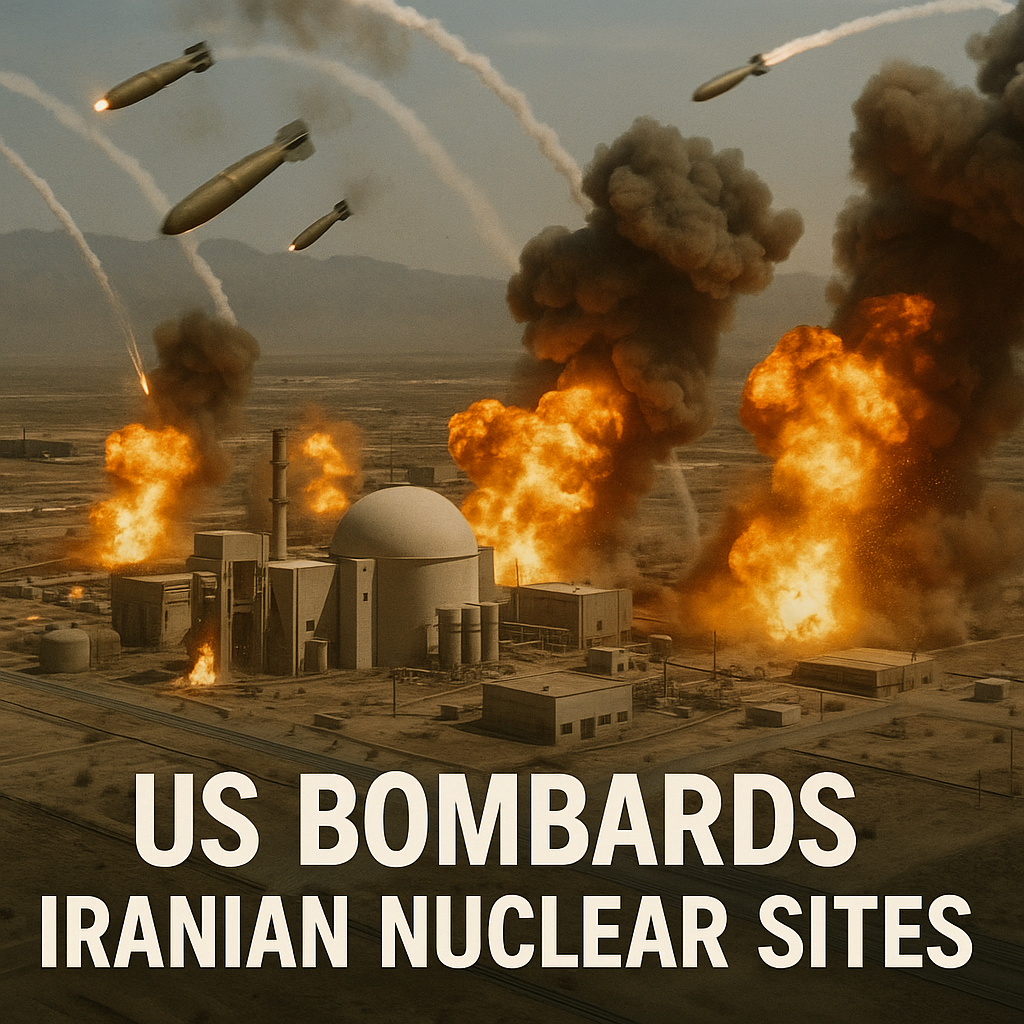How the US Bombarded Iranian Nuclear Sites Without Detection
1. Decoy Bombers Distract Attention
Two groups of B‑2 Spirit stealth bombers took off from Whiteman Air Force Base in Missouri. One group flew westward toward the Pacific, intentionally visible to spotters and media outlets. Meanwhile, a second group of seven B‑2s, each carrying GBU‑57 Massive Ordnance Penetrator (MOP) bombs, flew east toward Iran. These bombers maintained radio silence and flew under the radar, creating tactical surprise by drawing attention away from the real operation.(US Bombarded Iranian Nuclear Sites)
2. The Long, Covert Journey
The mission itself lasted an 18-hour round-trip, with multiple aerial refuels along the way. The B‑2 bombers were supported by fighter escorts and reconnaissance aircraft to ensure they could avoid detection.
The bombers flew undetected across regions like Lebanon, Syria, Iraq, and the Eastern Mediterranean, maintaining stealth until they entered Iranian airspace.
3. Simultaneous Multi‑Vector Attack
Submarine-launched Tomahawk missiles were fired at Iran’s Isfahan conversion facility about an hour before the bombers arrived. This initial strike helped further confuse Iranian radar and defense systems.At 2:10 a.m. Tehran time, the seven B‑2s dropped 14 GBU‑57 MOPs on Fordo and Natanz, Iran’s primary nuclear enrichment sites. These bombs were designed to penetrate deeply fortified underground structures.
The bombing run itself lasted about 25 minutes, with the bombers retreating from the area by 2:35 a.m. Tehran time.
4. Why Iran Didn’t Detect the Bombers
The B‑2’s stealth technology is specifically designed to evade radar detection, allowing it to fly undetected even by advanced air defense systems. Additionally, prior Israeli airstrikes had already dismantled much of Iran’s missile defense infrastructure, including its radar arrays, significantly weakening its ability to detect and respond to incoming threats. The combination of the decoy mission, electronic warfare, and a communications blackout ensured that Iranian defense systems were overwhelmed and misdirected, preventing any effective counter-response.
5. Unprecedented Use of the MOP
The GBU‑57 MOP is a 30,000-pound bomb designed to penetrate up to 60 meters (about 200 feet) of earth or concrete. This mission marked the first time the MOP was used in combat.
The bomb’s size and penetrating capability made it the only U.S. munition capable of reaching the deeply buried facilities at Fordo, which were shielded by thick rock layers to prevent airstrikes.
A decoy plan
Divided Iran’s attention between multiple potential threats.Prevented a coordinated air-defense response.Allowed the real bombers to reach heavily fortified sites like Fordo and Natanz undetected.
🔄 Step-by-Step Breakdown of the Decoy Maneuver
1. Two-Wave B‑2 Bomber Deployment
Visible Group: A group of B‑2 stealth bombers took off from Whiteman Air Force Base in Missouri and headed west across the Pacific. This route led toward Asia, where U.S. surveillance and bomber flights are common. These aircraft were intentionally visible to satellite trackers, military observers, and open-source aviation monitoring. Real Strike Group: Simultaneously, seven other B‑2s loaded with GBU‑57 bunker-busters flew east toward Europe and the Middle East. They maintained radio silence, flew at high altitudes, and avoided radar detection thanks to stealth technology. Aerial refueling tankers were staged across NATO and Gulf state airspace to support this route.(US Bombarded Iranian Nuclear Sites)
2. Purpose of the Decoy Flight
The westbound B‑2s drew attention away from the actual mission path. Intelligence agencies, including Iran’s, were likely watching satellite feeds and international aviation radar. This maneuver suggested a U.S. show of force elsewhere, likely over the Pacific or East Asia, possibly aimed at China or North Korea.
3. Electronic Warfare & Signal Jamming
Electronic warfare aircraft and reconnaissance drones accompanied the mission, targeting Iranian radar and communications systems. These jammed, spoofed, or suppressed radar networks make it harder for Iranian defenses to differentiate real targets from false ones.
4. Complemented by Submarine-Launched Missiles
Roughly one hour before the bomber strike, U.S. Navy submarines launched Tomahawk cruise missiles toward other Iranian facilities (like Isfahan). This added confusion and spread Iran’s air defense response across multiple sites.
A multifaceted attack
⚔️ Multifaceted U.S. Attack on Iranian Nuclear Sites — Key Components
1. Stealth Bomber Precision Strike
Seven B‑2 Spirit stealth bombers, each carrying two GBU‑57 Massive Ordnance Penetrators (MOPs), were the centerpiece. These 30,000-lb bombs were used to target deeply buried sites, especially. (US Bombarded Iranian Nuclear Sites)
Fordo: An underground uranium enrichment site beneath 250+ feet of rock.
Natanz: Another hardened facility previously hit by cyberattacks (Stuxnet). The bombers flew undetected, using stealth profiles, radio silence, and electronic countermeasures.
2. Submarine-Launched Cruise Missiles
U.S. Navy submarines in the Persian Gulf and Eastern Mediterranean launched Tomahawk cruise missiles roughly one hour before the B‑2s reached their target.
Targets included: Isfahan uranium conversion facilityCommand & control centersSurface-to-air missile sites. Strikes acted as both a tactical diversion and a first wave to degrade defenses
These strikes acted as both a tactical diversion and a first wave to degrade defenses.
3. Electronic Warfare & Cyber Disruption
U.S. RC-135 Rivet Joint aircraft and EA-18G Growlers jammed Iranian radar and comms. Cyber units (possibly NSA/Cyber Command) may have: Blinded radar arraysInjected false target tracksTemporarily disabled air defense coordination networksIran’s radar operators were flooded with noise, slowing or misdirecting any response. Iran’s radar operators were flooded with noise, slowing or misdirecting any response. (US Bombarded Iranian Nuclear Sites)
4. Airborne Refueling and Fighter Cover
Mid-air refueling (KC-135 and KC-46 tankers) enabled the 18+ hour mission. Fighter escorts (F-22s and F-15s) flew in support corridors to deter enemy aircraft.AWACS (Airborne Warning and Control Systems) provided real-time targeting and communication links.
5. Decoy Operations
A separate flight of B‑2s and possibly drones flew west to simulate a Pacific-based threat, creating a false operational narrative. This masked the true direction of the real strike team flying over the Mediterranean and the Middle East. ( US Bombarded Iranian Nuclear Sites )
🧠 Strategic Takeaways
| Element | Purpose | Effect |
| B‑2 Bombers | Strike-hardened nuclear sites | Precision destruction |
| Tomahawk Missiles | Preemptive & distracting strike | Radar & missile site degradation |
| EW & Cyber Ops | Blind and confused defenses | No detection or coordinated response |
| Decoy Flights | Misdirect enemy intelligence | The wrong theater focused on |
| Refueling & AWACS | Maintain mission endurance | Seamless coordination |
A look at the numbers
1. Stealth Bomber Strike (B‑2 Spirits)
7 B‑2 Spirit Bombers were used in the main strike. Each bomber carried two GBU‑57 MOPs, for a total of 14 bombs dropped on Fordo and Natanz.Each GBU‑57 MOP weighed around 30,000 pounds, designed to penetrate up to 60 meters (about 200 feet) of reinforced concrete or earth before detonating
2. Submarine-Launched Tomahawk Missiles
At least 10 Tomahawk cruise missiles were launched from U.S. submarines stationed in the Gulf and Mediterranean. Each missile has a range of about 1,000 miles, allowing U.S. submarines to launch from well outside Iranian territorial waters.
3. Mission Duration & Refueling
The entire operation lasted 18 hours, with bombers making the round trip from Whiteman Air Force Base in Missouri to Iran. Mid-air refueling occurred multiple times for the B‑2s and accompanying fighter aircraft, ensuring that the bombers could stay airborne for such a long-distance operation without landing.
4. Electronic Warfare (EW) Operations
RC-135 Rivet Joint and EA-18G Growler aircraft played crucial roles in jamming Iranian radar and communication systems. The Rivet Joint can intercept and analyze up to 1,000+ signals simultaneously, ensuring that Iran’s radar systems are overwhelmed. Cyber operations likely targeted Iranian military networks, potentially disrupting up to 50+ command and control centers across Iran. A separate flight of 4-5 B‑2s was deployed as a decoy, flying west toward the Pacific. This “distraction” ensured Iranian air defense systems were focused on a non-existent threat, while the real strike force approached undetected.
5. Total Coordination & Scale
This entire operation involved over 100 aircraft, including bombers, fighters, tankers, reconnaissance planes, and electronic warfare systems. The U.S. deployed multiple layers of defense to ensure that Iran’s response could be intercepted or confused, ensuring near-total surprise.
In Summary:
The numbers reveal how this was a highly coordinated, multi-pronged attack:
7 B‑2 bombers
14 Massive Ordnance Penetrator bombs
10+ Tomahawk missiles
100+ aircraft in total
18 hours of sustained operations
A female pilot
A female pilot taking part in such a high-stakes military operation would be a fascinating and inspiring aspect of the mission. While specific names or instances of female pilots directly involved in this particular strike may not be publicly available, we can still explore the role of women in modern military aviation and how they’ve contributed to similar missions.
In Stealth Operations recent years, female pilots have increasingly played pivotal roles in the U.S. Air Force, Navy, and other military branches. Many women have flown fighter jets, bombers, and stealth aircraft, including the B‑2 Spirit bombers used in high-profile operations like the one against Iran.
Key Facts: Women in Combat Aviation
First Female Fighter Pilot: Captain Martha McSally became the first female fighter pilot to fly in combat during the Gulf War in the 1990s. She later went on to become the first female U.S. senator from Arizona.
Female B‑2 Spirit Pilots: The B‑2 Spirit stealth bomber is one of the most technologically advanced aircraft in the U.S. fleet, requiring exceptional training and skill. Women have served as pilots and crew members on these missions. The U.S. Air Force has no gender restrictions on who can fly the B‑2, meaning women have been part of missions that involve precision strikes like the one you’re referencing.
Combat Readiness: Female pilots must go through the same demanding selection processes, physical tests, and technical training as their male counterparts. They often have to deal with the added pressure of being in the minority in a historically male-dominated field.
Hypothetical Role of a Female Pilot in the Mission
If we imagine a female pilot involved in the U.S. operation against Iranian nuclear sites, here’s how her role might unfold:
Stealth Bomber Operations:
She could have been one of the pilots of the B‑2 Spirit, tasked with delivering the GBU‑57 MOPs to deeply buried nuclear facilities like Fordo and Natanz. She would have flown in a high-pressure, high-stakes environment, requiring precision navigation, flawless execution of bombing runs, and perfect coordination with aerial refueling tankers and escort fighters.
Team Coordination:
The B‑2 bomber crews typically operate in pairs (pilot and co-pilot), making team coordination essential. A female pilot could have worked closely with her male or female co-pilot, executing.
The strike while dealing with real-time changes in weather, enemy radar, or airspace restrictions.
Operational Stealth:
As a stealth bomber pilot, she would have had to maintain the lowest radar profile possible, ensuring that the bombers flew undetected by Iranian air defense systems.
Her training would have prepared her for moments of tension, managing the aircraft’s high-tech systems and making split-second decisions in the face of danger or adversity.
Aftermath & Media:
If part of the debriefing or media response, she might have spoken about the critical importance of women in combat aviation, sharing how gender doesn’t factor into the effectiveness of military operations—only skill, training, and teamwork do.
Inspirational Female Combat Aviators
A few notable women in combat aviation who might serve as inspiration for such a role:
Major General Linda Singh (U.S. Army): First female adjutant general of the Maryland National Guard, overseeing operations that might involve strategic missions similar to the one targeting Iran.
Lieutenant Colonel Amy McGrath (U.S. Marine Corps): One of the first women to fly combat missions in the F/A-18 Hornet. She became the first woman to fly a combat mission as part of a Marine Corps fighter squadron in 2002.
Representation in the U.S. Air Force
The U.S. Air Force has opened combat aviation roles to women since the 1990s, and there’s been a consistent increase in women assuming leadership roles within the aviation sector, including on bomber crews. The U.S. Navy and Air Force now have female pilots flying frontline combat aircraft such as the F-35 Lightning II and B‑2 Spirit.








It’s fascinating how the U.S. managed to create such a complex deception strategy with decoy bombers. The use of a multi-vector attack definitely added an element of surprise and disrupted Iran’s radar. I wonder how future advancements in AI and cyber warfare might further enhance these stealth tactics.